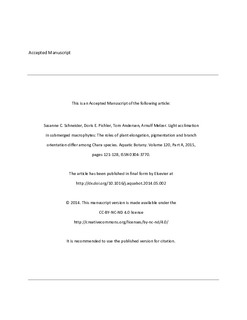| dc.contributor.author | Schneider, Susanne Claudia | |
| dc.contributor.author | Pichler, Doris E. | |
| dc.contributor.author | Andersen, Tom | |
| dc.contributor.author | Melzer, Arnulf | |
| dc.date.accessioned | 2018-11-05T13:35:52Z | |
| dc.date.available | 2018-11-05T13:35:52Z | |
| dc.date.created | 2015-01-28T17:18:59Z | |
| dc.date.issued | 2015 | |
| dc.identifier.citation | Aquatic Botany. 2015, 120 (Part A), 121-128. | nb_NO |
| dc.identifier.issn | 0304-3770 | |
| dc.identifier.uri | http://hdl.handle.net/11250/2571012 | |
| dc.description.abstract | Light acclimation plays a fundamental role for plant survival. Using an experimental setup where light could only penetrate from above, we studied light acclimation of Chara intermedia and C. contraria, i.e. submerged macroscopic algae which grow in an upright position. Both species produced taller plants at higher light intensities. These results are in contrast to earlier studies which found shorter plants at higher light intensities. This may be explained by light-induced inhibition of shoot-cell elongation. Since Chara shoot-cells point upward, the inhibition can only operate when light reaches plants laterally. We suggest that calcium-encrustation, periphyton-cover and dense neighboring vegetation may reduce lateral light such that plants exposed to such conditions will show increased elongation with increasing light intensity.
In contrast to expectations, the uppermost Chara parts had higher chlorophyll a/carotenoid ratios, indicating less light protecting capacity, than the lower parts. This is explained by branches of the uppermost parts generally pointing upward such that they become less light exposed than branches of lower parts, which were less inclined. We found that the more nearly horizontal Chara branches had steeper slopes in their chlorophyll a/carotenoid ratio in relation to light intensity, indicating that the intensity of adjustments in pigmentation depends on branch orientation. C. intermedia adjusted orientation of growing branches to incident light, with branches pointing steeply upward at high light conditions, while C. contraria did not. The combination of branch-orientation and adaptations in pigmentation may give C. intermedia a competitive advantage over C. contraria in high light environments. | nb_NO |
| dc.language.iso | eng | nb_NO |
| dc.publisher | Elsevier | nb_NO |
| dc.rights | Attribution-NonCommercial-NoDerivatives 4.0 Internasjonal | * |
| dc.rights.uri | http://creativecommons.org/licenses/by-nc-nd/4.0/deed.no | * |
| dc.title | Light acclimation in submerged macrophytes: The roles of plant elongation, pigmentation and branch orientation differ among Chara species | nb_NO |
| dc.title.alternative | Light acclimation in submerged macrophytes: The roles of plant elongation, pigmentation and branch orientation differ among Chara species | nb_NO |
| dc.type | Journal article | nb_NO |
| dc.type | Peer reviewed | nb_NO |
| dc.description.version | acceptedVersion | nb_NO |
| dc.source.pagenumber | 121-128 | nb_NO |
| dc.source.volume | 120 | nb_NO |
| dc.source.journal | Aquatic Botany | nb_NO |
| dc.source.issue | Part A | nb_NO |
| dc.identifier.doi | 10.1016/j.aquabot.2014.05.002 | |
| dc.identifier.cristin | 1210165 | |
| cristin.unitcode | 7464,30,19,0 | |
| cristin.unitname | Ferskvannsøkologi | |
| cristin.ispublished | true | |
| cristin.fulltext | postprint | |
| cristin.qualitycode | 1 | |

